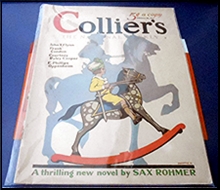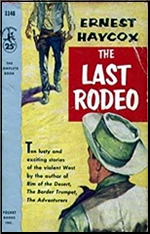Fri 4 Jan 2019
Western Stories I’m Reading, by David Vineyard: ERNEST HAYCOX “Dolorosa, Here I Come.”
Posted by Steve under Stories I'm Reading , Western Fiction[3] Comments
ERNEST HAYCOX “Dolorosa, Here I Come.” Collier’s, 28 February 1931. Collected in The Last Rodeo (Little, Brown & Co., hardcover, 1949; Pocket, paperback, 1956).

Danny Dale is the young trail boss of an outfit out of Texas, hard young men worn with the deprivations of the trail and anxious to let off some steam, and Dolorosa, like a fat hungry spider, sits before them offering shallow glitter, and cheap whiskey. Not surprisingly things go bad, when Bill, one of Dale’s boys, kills a crooked roulette dealer and in turn is killed by the local lawman, Lingersen (“The man is a remorseless killer. He has been here only a year but in that time he has been like the terror. He has bullied and beaten and destroyed. Everybody hates him; nobody dares cross him.â€).
But Danny sees it as a fair exchange, a life for a life and returns only to bury his friend and settle up any debts, and it is then he meets Gracie an independent young woman, who owns a small restaurant and hates what Dolorosa is.
“Dolorosa. Here I Come†first appeared in Collier’s in 1931, one of slicks (the high paying magazines printed on slick paper which most pulp writers aspired to crack) which Haycox cracked long before the story that made him one of the most admired Western writers of his age, “The Last Stage to Lordsburg,†famously a retelling of Guy de Maupassant’s “Boule de Soufâ€, that John Ford made into the film that gave birth to the modern adult Western, Stagecoach.
In any Haycox Western the power and control of the writing is hard to miss. There is a lyricism to his words that captures not only the mythic and larger than life qualities of the West, but also the simplicity and purity of the classic form. It is little wonder that Haycox went on to be far more than a popular Western writer penning not only Westerns, but a handful of bestselling historical novels of the West like The Adventurers and Canyon Passage that were offered by major book clubs and optioned by Hollywood.

Of the period he wrote in, Haycox was both one of the most popular and most respected writers to take up the Western, a rarity, in that he was recognized far beyond the confines of the pulps with probably only Luke Short (Fred Glidden) running him a close race in the high paying slicks of the era, yet he was also recognized as a master of action and drama.
True to heavies from time immemorial Lingersen can’t leave good enough alone and braces Danny on his return to bury his friend:
“Does the warnin’ mean you’ll reach for the hardware at ten sharp without added talk?”
Lingersen said: “I never warn twice and I never go back on my word.”
“Just wanted to get it clear,” mused Danny Dale. “I’m a great hand for havin’ things straight.”
Okay, I’ll grant you there are more dropped ‘g’s’ in this tale than all of Philo Vance and Peter Wimsey, but still it sounds and feels authentic and at the same time mythic, and that combination of the dusty sweaty hard real West with the mythic Technicolor wide-screen West of the big screen is one of the keys to why Haycox is remembered and still read.
Haycox is too good a writer to spare us the promised showdown, and much too good to offer us a story in which that is all there is, the twist at the end an almost O Henryesque moment. Without giving it away, I’ll only say Haycox isn’t offering us simple villains and heroes and doesn’t pretend that any duel to the death is without its ironies.
This last is just a scene as the boys ride out of town. You have read or seen it’s like in a thousand films and Western novels and stories, but listen to the simple lyric description of the following passage. “Dolorosa, Here I Come,†is a slight example of Haycox talent, but more a vivid reminder of why his name was legend in the genre and why he was envied by so many of his fellow writers of the purple sage:
January 4th, 2019 at 7:33 am
What I notice about Haycox is that his heroes are generally (maybe always?) working men: miners, ranchers, freighters and trail hands, not lawmen, gunfighters or whatever. It adds a certain realism to his stories, and doesn’t stint the action at all.
January 4th, 2019 at 7:26 pm
Dan, Even when they are outlaws or lawmen they tend to be ordinary working stiffs who find themselves in that role like the Ringo Kid in “Lordsburg.”
Film historians tend to dismiss Haycox and his original story, but quite a bit of the film is in the original story, and it is clear it was no accident the story mirrored the de Maupassant classic.
Haycox could and did write fast action hard hitting Western stories that fit right in the pulp Western tradition, in fact he was one of the kings, but he also belonged to a more expansive Western sub genre of writers with a shade more literary goals and skills.
January 5th, 2019 at 4:42 pm
I like his pulp westerns far more than I do his historical westerns, but even so, I haven’t read enough of them to realize what kinds of work his heroes really do. I’m glad you pointed it out, Dan. Thanks! I’ll keep it in mind the next time I read one of his stories.